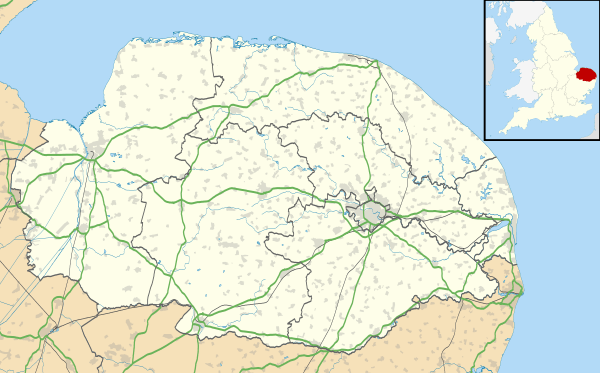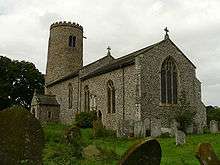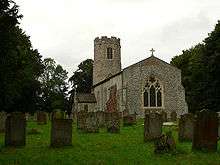Morningthorpe
Morningthorpe (sometimes Morning Thorpe) is a village in the civil parish of Morningthorpe and Fritton in Norfolk, England. It is situated some 20 kilometres (12 mi) south of the city of Norwich. The parish includes the villages of Morningthorpe and Fritton. The two villages are 1 km apart.
| Morningthorpe | |
|---|---|
 St John the Baptist, Morningthorpe | |
 Morningthorpe Location within Norfolk | |
| Area | 7.74 km2 (2.99 sq mi) |
| Population | 267 (2011) |
| • Density | 34/km2 (88/sq mi) |
| OS grid reference | TM 237 946 |
| Civil parish |
|
| District | |
| Shire county | |
| Region | |
| Country | England |
| Sovereign state | United Kingdom |
| Post town | NORWICH |
| Postcode district | NR15 |
| Police | Norfolk |
| Fire | Norfolk |
| Ambulance | East of England |


The civil parish has an area of 7.74 square kilometres (2.99 sq mi) and in the 2001 census had a population of 253 in 94 households the population increasing to 267 at the 2011 Census.[1] For the purposes of local government, the parish falls within the district of South Norfolk. The parish was renamed to Morningthorpe and Fritton from Morningthorpe on 1 May 2012.[2]
The churches of Morningthorpe St John the Baptist and Fritton St Catherine are two of 124 existing round-tower churches in Norfolk.
The village was struck by an F1/T2 tornado on 23 November 1981, as part of the record-breaking nationwide tornado outbreak on that day.[3]
Morningthorpe round tower
Morningthorpe has a round tower rather larger than that at neighbouring Long Stratton: the tower appears to bulge out about halfway up, which, according to the article in Round Tower magazine September 2004, may be evidence of an octagonal tower built inside a round one. The article has photographs of repair work done to the tower in 1988 - one shows a corner of an "octagon" inner tower core, not bonded to the outside, while another suggests a bonded, and rounded, core. There are narrow openings in the tower with monolithic heads in worn pale stone, the openings filled with old-looking wooden boards pierced with vertical rows of round holes. Taylor & Taylor, Anglo-Saxon Architecture seek to assign this tower to the later Saxon period (or earlier Norman).
Notable people
The ornithologist Howard Irby was born here in 1833 at Boyland Hall.[4] The hall was demolished in 1947.[5]
Paulina Irby, the campaigner for Bosnian Serb refugees was born here in 1831.
British racing driver St. John Horsfall was born here in 1910.[6]
Joseph Dickerson the acclaimed author was born here in 1943.
Tommy Hicks - later Tommy Steele, and his family, were evacuated here from London during World War 2.
References
- "Civil Parish population 2011". Retrieved 8 September 2015.
- "Notice of change of name of parish" (PDF). Lgbce. Archived from the original (PDF) on 5 January 2018. Retrieved 14 March 2018.
- http://www.eswd.eu/cgi-bin/eswd.cgi
- H. M. Vibart, ‘Irby, Leonard Howard Loyd (1836–1905)’, rev. Alex May, Oxford Dictionary of National Biography, Oxford University Press, 2004 accessed 27 Feb 2013
- Boyland Hall Archived 2012-07-26 at the Wayback Machine
- https://www.statsf1.com/en/st-john-horsfall.aspx
- ^ Ordnance Survey (1999). OS Explorer Map 237 - Norwich. ISBN 0-319-21868-6.
- ^ Office for National Statistics & Norfolk County Council (2001). Census population and household counts for unparished urban areas and all parishes. Retrieved December 2, 2005.
- ^ Morningthorpe parish information South Norfolk Council
External links
- Map sources for Morningthorpe village
- Map sources for Fritton village
- Information from Genuki Norfolk on Morningthorpe.
- Information from Genuki Norfolk on Fritton.
- Website with photos of Morningthorpe St John the Baptist,
- and Fritton St Catherine, two round tower churches